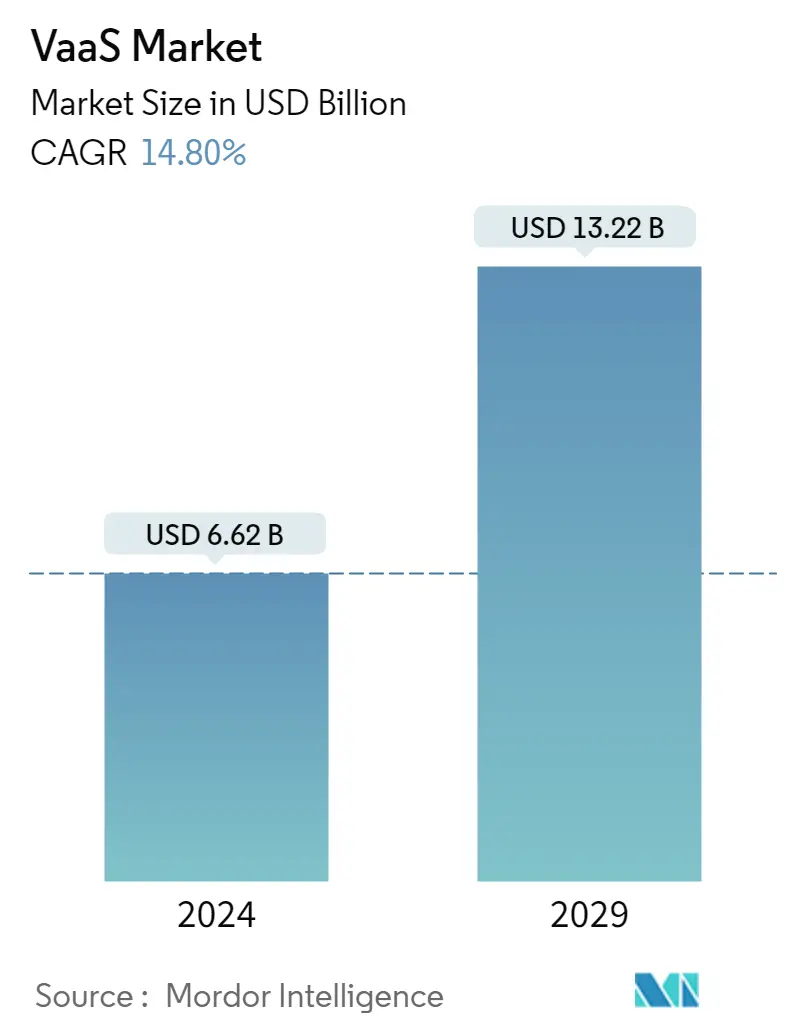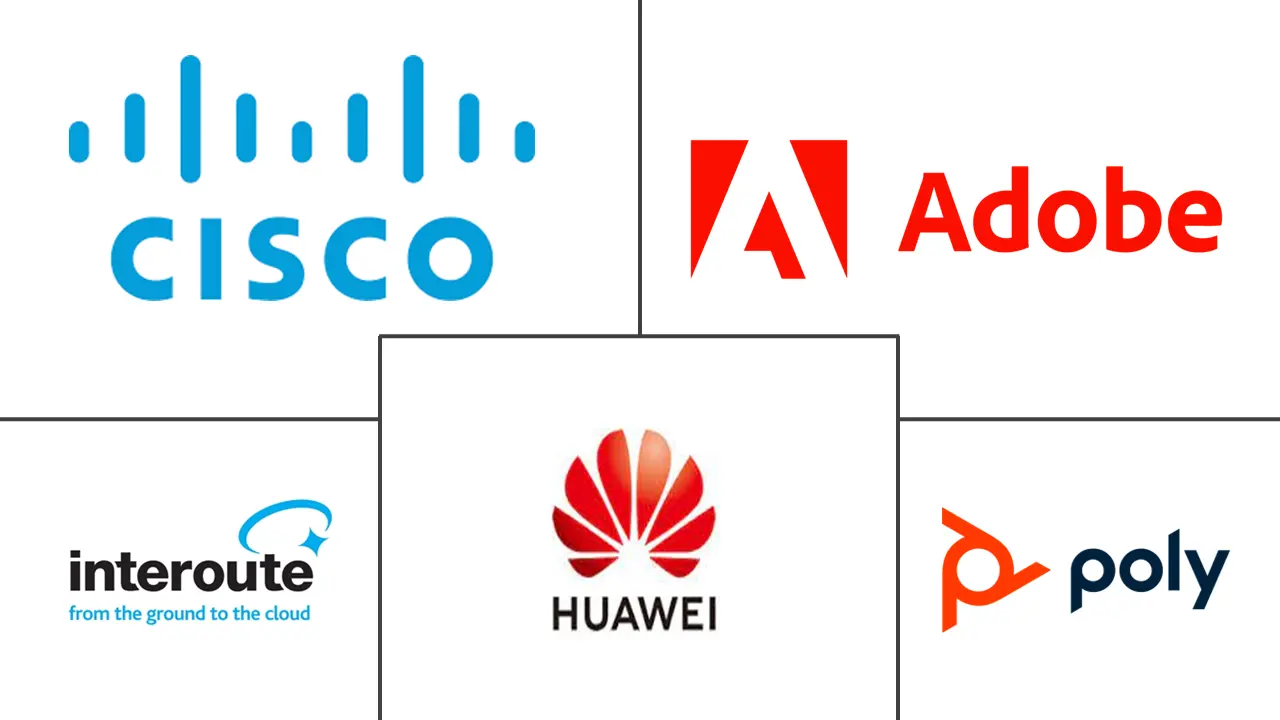Market Size of VaaS Industry

| Study Period | 2019 - 2029 |
| Market Size (2024) | USD 6.62 Billion |
| Market Size (2029) | USD 13.22 Billion |
| CAGR (2024 - 2029) | 14.80 % |
| Fastest Growing Market | Asia Pacific |
| Largest Market | North America |
| Market Concentration | Low |
Major Players
*Disclaimer: Major Players sorted in no particular order |
Video as a Service Market Analysis
The VaaS Market size is estimated at USD 6.62 billion in 2024, and is expected to reach USD 13.22 billion by 2029, growing at a CAGR of 14.80% during the forecast period (2024-2029).
Video as a Service (VaaS) is a cloud-based video communication service that allows users to conduct video conferences, video calls, and live video streaming over the Internet. VaaS providers offer the necessary infrastructure, software, and tools to enable businesses and individuals to communicate through video.
- Due to the high scalability, flexibility, and affordability provided by the cloud architecture, there is a discernible movement in demand away from on-premises video conferencing (VC) and collaboration solutions to cloud-based solutions. The popularity of cloud-based solutions has accelerated the demand for video as a service (VaaS). It saves time and travel expenses, as participants can collaborate from anywhere with an Internet connection. It also provides meeting transcription services, which can assist with product presentations, financial reviews, and other types of meetings.
- VaaS enhances productivity and efficiency, as participants can easily share and collaborate on documents and presentations in real time. Several video conferencing solutions vendors have implemented various business models to better serve their clients. Solution providers are putting their efforts into providing solutions specifically tailored to satisfy the needs of multiple enterprises.
- The use of cloud-based solutions is also increasing, as are the expenditures made to add new capabilities like immersive telepresence, voice and face recognition, HD audio and video, and artificial intelligence (AI). There will likely be more competition among the market players due to advancements in technology, innovations, and the entry of new VaaS solution providers, which would facilitate small and medium businesses to utilize affordable hybrid cloud-based collaboration and VC solutions.
- Further, VaaS can have various uses in the healthcare sector, such as remote healthcare services, telemedicine, video consultations, medical education, etc. With video conferencing, physicians and medical staff can interact with patients in real time, regardless of their physical location, which can be beneficial for patients who may have difficulty traveling. Additionally, medical staff can receive remote training and collaborate with other professionals in real time using video conferencing, which can improve the quality of care provided to patients.
- The market players are strategically deploying advanced VaaS to expand their presence and capture the market share. For instance, in October 2022, Pexip, an international provider of video technology, launched Pexip's Video Platform as a Service. With the service, the company hopes to empower big businesses to create innovative new products, incorporate video into workflows, and innovate. (VPaaS). Pexip's organizational structure, which currently comprises a new business unit with dedicated technical and commercial resources throughout the Americas, EMEA, and APAC, supports the company's focus on video innovation. Customer and citizen engagement, healthcare, and video-enabled extended reality are claimed to be the three major growth areas that this team is focusing on.
- Additionally, there are several uses of video as a service in the defense sector. Video surveillance is one such use, where cameras are used for security purposes. Additionally, video conferencing can be used by the government and defense sector for communication and collaboration. The defense sector can also use cloud services to store and access mission-critical data. Furthermore, innovative digital applications and services can be leveraged by the military and defense communication industry. The defense sector is influenced by various macroeconomic trends such as government spending, economic growth, and global economic conditions.
- On the other side, high acquisition and integration costs and data security and privacy concerns restrain the growth of the studied market. Several false alarms are triggered as a result of malfunctioning equipment and unfavorable weather or environmental conditions. Data security and privacy issues are anticipated to be a roadblock due to the service’s poor integration or lack of system synchronization.
Video as a Service Industry Segmentation
The video as a service market is a fully managed visual communication solution complete with high capacity, low latency connectivity. Majorly, managed services in small and medium businesses include video conferencing and video communication, which are used mostly in organizations to run day-to-day business models.
The video as a service market is segmented by platform (application management, device management, and network management), device (mobility devices and enterprise computing), service (managed and professional), by deployment model (public cloud, private cloud, and hybrid cloud), end-user industry (government and defense, BFSI, healthcare, it & telecom, media & entertainment, manufacturing, and other end-user industries), and geography ( North America, Europe, Asia-Pacific, Latin America and Middle East, and Africa). The market sizes and forecasts are provided in terms of value (USD) for all the above segments.
| By Platform | |
| Application Management | |
| Device Management | |
| Network Management |
| By Device | |
| Mobility Devices | |
| Enterprise Computing |
| By Service | |
| Managed | |
| Professional |
| By Deployment Model | |
| Public Cloud | |
| Private Cloud | |
| Hybrid Cloud |
| By End-user Industry | |
| Government and Defense | |
| BFSI | |
| Healthcare | |
| IT & Telecom | |
| Media & Entertainment | |
| Manufacturing | |
| Other End-user Industries |
| Geography*** | |
| North America | |
| Europe | |
| Asia | |
| Latin America | |
| Middle East and Africa |
VaaS Market Size Summary
The Video as a Service (VaaS) market is experiencing significant growth, driven by the increasing demand for cloud-based video communication solutions. VaaS offers scalable, flexible, and cost-effective alternatives to traditional on-premises video conferencing systems, enabling users to conduct video calls, conferences, and live streaming over the Internet. This shift towards cloud solutions is fueled by the need for remote collaboration, reducing travel costs, and enhancing productivity through real-time document sharing and collaboration. The market is characterized by the introduction of advanced features such as immersive telepresence, AI-driven enhancements, and integration with other technologies, which are attracting a diverse range of industries, including healthcare and defense, to adopt VaaS solutions.
The market landscape is highly competitive, with major players like Cisco Systems, Huawei Technologies, and Adobe Systems continuously innovating to maintain their market positions. The adoption of hybrid cloud solutions is also on the rise, offering organizations the ability to scale resources efficiently while addressing data security concerns. The introduction of 5G technology is expected to further boost the VaaS market by enabling faster and more reliable video streaming services. As companies expand their VaaS capabilities, the focus on security and integrated solutions is becoming increasingly important, with providers offering multilayer security services to meet consumer demands. The market's growth is supported by strategic partnerships and technological advancements, positioning VaaS as a critical component of modern communication infrastructure.
VaaS Market Size - Table of Contents
-
1. MARKET INSIGHTS
-
1.1 Market Overview
-
1.2 Industry Attractiveness - Porter's Five Forces Analysis
-
1.2.1 Threat of New Entrants
-
1.2.2 Bargaining Power of Buyers/Consumers
-
1.2.3 Bargaining Power of Suppliers
-
1.2.4 Threat of Substitute Products
-
1.2.5 Intensity of Competitive Rivalry
-
-
1.3 Assessment of Impact of Macro Economic Trends on the Market
-
-
2. MARKET SEGMENTATION
-
2.1 By Platform
-
2.1.1 Application Management
-
2.1.2 Device Management
-
2.1.3 Network Management
-
-
2.2 By Device
-
2.2.1 Mobility Devices
-
2.2.2 Enterprise Computing
-
-
2.3 By Service
-
2.3.1 Managed
-
2.3.2 Professional
-
-
2.4 By Deployment Model
-
2.4.1 Public Cloud
-
2.4.2 Private Cloud
-
2.4.3 Hybrid Cloud
-
-
2.5 By End-user Industry
-
2.5.1 Government and Defense
-
2.5.2 BFSI
-
2.5.3 Healthcare
-
2.5.4 IT & Telecom
-
2.5.5 Media & Entertainment
-
2.5.6 Manufacturing
-
2.5.7 Other End-user Industries
-
-
2.6 Geography***
-
2.6.1 North America
-
2.6.2 Europe
-
2.6.3 Asia
-
2.6.4 Latin America
-
2.6.5 Middle East and Africa
-
-
VaaS Market Size FAQs
How big is the VaaS Market?
The VaaS Market size is expected to reach USD 6.62 billion in 2024 and grow at a CAGR of 14.80% to reach USD 13.22 billion by 2029.
What is the current VaaS Market size?
In 2024, the VaaS Market size is expected to reach USD 6.62 billion.

